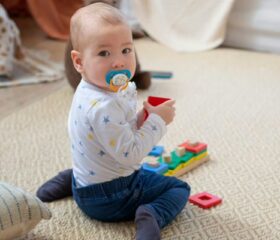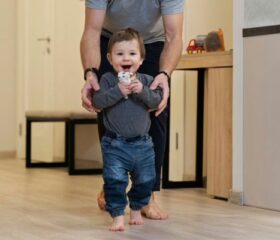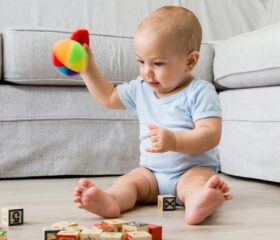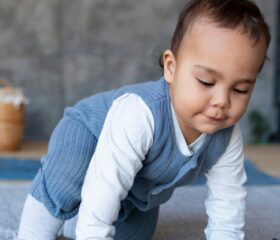Baby Month by Month
6-Month-Old Baby
There’s a big milestone this month—your baby may be ready for solids!

Give yourself a pat on the back. As beautiful as the first few months are, they’re definitely no walk in the park, but you got through them like a champ.
You’re now looking at a smiley 6-month-old who’s curious about the world and eager to be on the move. She’ll reach many milestones this month (potentially including her first foray into eating solids).
Let’s dive into what you can expect from your 6-month-old and how to care for her at this stage.
Your baby’s developmental milestones at 6 months
Your 6-month-old is engaging and interacting with the world around her more than ever before.
As she gets more mobile, expressive, and social, her adorable (and sometimes frustrating) quirks and characteristics will really start to shine through.
Your baby’s physical development
All that tummy time has paid off, and your baby is stronger than ever before. You may notice her hitting new physical milestones like:
- Sitting up: By now, your baby may be able to sit up unsupported for up to 30 seconds or more. At first, she might wobble as she attempts to sit, but she’ll strengthen her core and improve her balance with more practice. 1
- Digestive control: Notably, sitting independently often coincides with when most babies stop spitting up. Don’t worry if she keeps doing that occasionally for another month or so, but now’s when you can expect those messy eruptions to get less frequent.
- Increased mobility: She’s now good at rolling over—both from her tummy to back and back to tummy. When she’s on her tummy, she can push her arms straight to raise her shoulders and head. 1
- Better hand-eye coordination: Your baby will reach for objects more purposefully, grasp them more firmly, and may even pass toys from one hand to the other. She’ll want to put almost everything she holds into her mouth out of curiosity. 2
How big is an average 6-month-old?
As you’ve probably noticed, your baby has been growing steadily over the past few months. In fact, she may have doubled her birth weight by now. 3
Her growth may be slower in the second half of her first year of life. As you track her growth, don’t compare it with other babies. There’s a wide range of healthy weights and lengths; as long as she keeps on developing according to her own growth curve (as described by your doctor), there’s nothing you need to worry about.
Your baby’s cognitive and emotional development
Alongside her physical development, your baby’s cognitive and emotional skills are also improving. Here’s what you may notice at 6 months:
- Communication: This 6-month mark is generally around when babies start babbling, although some also start a few months earlier. Either way, you may hear your child trying out more consonant and vowel sounds. She might start stringing sounds together like “ba-ba” or “da-da,” although these sounds don’t have any real meaning yet. 4 You may also notice she’s responding to her own name and other simple words and gestures.
- Social engagement: Your baby recognizes and responds to familiar faces with big smiles, coos, and giggles. On the other hand, she may develop stranger anxiety and be wary of unfamiliar people.
- Imitation: Relatedly, she’ll try to imitate your sounds and expressions. This is great for her language development and social learning.
- Emotional range: You’ll notice a broader range of emotions in your baby, from joy and excitement to frustration and sadness. She’ll express these emotions more clearly through her facial expressions, vocalizations, and body language.
As your baby becomes more aware of the world around her, she may express her feelings more intensely and cry more often. This isn’t something you need to be concerned about; just be there to support and soothe her when she needs it.
Is your 6-month-old ready for solid foods?
The 6-month mark is when many babies start eating solid food. At this point, you can introduce her to pureed or mashed foods. You can consider baby-led weaning (BLW), or “auto-weaning,” which involves slowly introducing your baby to small portions of whatever foods your family is already having, in addition to the breastmilk or formula she drinks. 5
Make sure your 6-month-old shows signs of readiness first before feeding her solid foods. Keep an eye out for whether she can: 6
- Sit upright by herself or with only minimal support
- Control her head steadily
- Open her mouth when you feed her
- Swallow food instead of pushing it out with her tongue
- Grab objects and bring them to her mouth
While you may be eager to introduce solids, never rush into it. If your baby doesn’t show these signs, it’s OK to wait a little longer until she’s ready.
Breast milk or formula should still be your baby’s main source of nourishment
Breast milk or formula will remain your baby’s main source of nourishment until she’s 12 months old. In fact, according to the American Academy of Pediatrics, you can breastfeed your baby up to 2 years old (or even longer) if both you and your baby want to.
Tips for feeding your 6-month-old solid foods
Your baby is only beginning to learn how to eat, so it’ll take some time for her to get the hang of it. Start with a small amount, around half a spoonful or less, to ease her into eating solids.
You generally don’t need to introduce food in a certain order to your baby. Just make sure that they’re soft and well-mashed or pureed. Feed her a new single-ingredient food every 3–5 days at first. This lets you easily identify any food she could be allergic to. 6
Alternatively, if you’re going with the BLW route, instead of feeding your baby pureed foods, you’ll feed her small bits of what you’re eating, as mentioned. You’ll let your baby feed herself and eat as much or as little as she wants. Ideally, she’ll be sitting at the table eating with your family.
Benefits of baby-led weaning
There are plenty of benefits to BLW, such as: 57
- More independence: BLW gives your baby extra independence and more chances to practice her hand-eye coordination. She’ll also get the benefit of exploring foods with all five of her senses.
- Less chance of becoming picky: Your baby may be less likely to be a picky eater and overweight when she grows up.
- Less stress for you: As a cherry on top, you won’t need to prepare baby food for her, and you get to enjoy mealtimes as a family.
Is baby-led weaning safe?
BLW isn’t without its risks. There’s a small chance that your baby might choke when feeding herself. Moreover, she might not get enough calories (e.g., if she favors certain lower-calorie foods over higher-calorie ones). 5
Ultimately, it’s up to you to decide whether BLW is right for your baby. You can always consult with your pediatrician if you’re unsure what to do.
Safe and unsafe foods and drinks for your baby
While you’ll want to diversify your baby’s diet, it’s important to know which foods and drinks are safe.
Check out the table below to get an idea of which foods and drinks are safe and unsafe for your 6-month-old baby: 6 8 9
| Foods to introduce to your baby | Potentially allergenic foods (introduce them one at a time) | Foods to avoid giving your baby |
|---|---|---|
| - Infant cereals - Meat or other proteins - Fruits - Vegetables - Grains - Yogurts (made from pasteurized milk) - Cheese (made from pasteurized milk) |
- Dairy products (should be full fat, e.g., whole milk yogurt) - Eggs - Peanuts - Tree nuts - Shellfish - Fish - Wheat - Soy - Sesame |
- Cow’s milk beverages - Fortified soy beverages - Honey - Unpasteurized food and drinks - Raw foods (especially raw animal or seafood products, e.g., sushi) - Potential choking hazards (e.g., large pieces of raw vegetables or hot dogs) |
Telltale signs of an allergic reaction
Whenever you introduce a new food, always monitor your baby for the signs of an allergic reaction. Get in touch with your pediatrician right away if she has: 10
- Hives or rash
- Swelling of the face, eyelids, lips, or tongue
- Vomiting, diarrhea, or stools with blood
- Shortness of breath or labored breathing
Be aware that these symptoms can show up within a few minutes to an hour after eating an allergenic food. Keep a close eye on her for at least an hour after she eats a new food.
Your baby’s sleep patterns at 6 months
Breathe a sigh of relief; your 6-month-old’s sleeping pattern may get more predictable. Your baby might even start sleeping through the night (a stretch of about 6–8 hours)—a milestone that around two-thirds of babies achieve at this age. 11
How much sleep does your baby need?
Right now, she still needs around 12–15 hours of sleep within a 24-hour period and 1–2 naps during the day. Make sure she gets those daytime naps in, as they can help her sleep better during the night. 12
How to encourage better sleep habits
A consistent bedtime routine is one of the best ways to foster better sleep habits in your baby. If you start her routine at the same time each night, she’ll know when it’s time to rest. You could run her a bath, read her a story, or put pajamas on together; just avoid any over-stimulating activities (e.g., peek-a-boo).
If she still wakes up during the night, keep the lights dim and your interactions with her minimal and boring.
How to keep your 6-month-old healthy and safe
Your baby has grown a lot, but she’s still vulnerable. Here’s how to keep her safe at 6 months old.
Take her for her 6-month well-baby checkup
Your baby is due for another well-baby visit at 6 months. During this visit, your doctor will assess her overall health, growth, and development.
Feel free to bring up any persistent or recurring issues your baby has had, like sleeping problems, different types of diaper rashes, baby acne, or flakes on her scalp (cradle cap), even if you think it’s something minor. Your doctor is there to help, after all.
Vaccines are also important at this stage, and your doctor may administer your baby’s third dose of the following shots: 13
- Rotavirus vaccine
- Diphtheria, tetanus, acellular pertussis (DTaP) vaccine
- Haemophilus influenzae type B (Hib) vaccine
- Pneumococcal conjugate vaccine (PCV)
- Inactivated polio vaccine (IPV)
- Hepatitis B vaccine (HBV)
The CDC suggests that anyone over 6 months old get the influenza vaccine every year unless their doctor says otherwise. 14 Chat with your doctor about whether your baby is ready for her flu shot.
It’s also a good idea to vaccinate your baby against COVID-19 (this might take a series of shots rather than a single dose).
Along with these important vaccines, make sure your baby also gets her respiratory syncytial virus (RSV) antibody shot, if she hasn’t had it already. 15 This common respiratory virus can be fatal for babies and young children, and all kids under 8 months old should get one dose of the immunization shot. 16
Look after your baby at home
Now that your baby is more mobile, be extra vigilant around her. Don’t leave her unattended on a changing table or any elevated surface, as she can now sit up and roll over. You also need to be more careful during bathtime; make sure she’s always within arm’s reach.
Check if your baby still fits in her infant car seat. If not, it’s time to switch to a bigger one for her safety and comfort. This is also a good time to baby-proof your home, especially since she’ll be crawling before long.
For instance, you should:
- Cover all unused electrical outlets
- Install safety gates at the top and bottom of your stairways
- Keep small and sharp objects, cleaning products, and strings and cords out of your baby’s reach
- Cover all sharp corners with safety padding
- Install toilet and cabinet locks
If you’re heading outside, make sure your baby’s wearing an infant-safe sunscreen. The safest options are mineral sunscreens, such as those with zinc oxide or titanium oxide, since they won’t get absorbed by your baby’s skin. 17
Know the signs of teething
Your baby may start teething around this time; you can ask your doctor about how to soothe your baby if she has any teething discomfort during this check-up as well. You’ll know she’s already started teething if she: 18
- Often acts cranky or irritable
- Likes to bite or chew on hard objects
- Drools more than usual
- Has swollen gums
- Refuses to eat food
- Has sleeping problems
Of course, always bring up any other health concerns you have about your baby with your doctor.
Which activities should you do with your 6-month-old?
It’s not all diaper changes and messy mealtimes—playtime is just as important at 6 months. As well as being essential for her physical, cognitive, and emotional development, it’s way more fun and rewarding now, as your baby is more interactive than ever before.
Try the following activities to stimulate her development:
- Talk and read: Talk to your baby throughout the day. Narrate what you’re doing, sing songs, and read books to her. Even if she doesn’t fully understand the words, she’s listening to the sounds and rhythms of language. 19
- Mirror play: Your baby loves to look at herself in the mirror at this age. Looking at her own reflection is a great way to develop self-awareness. You can use a baby-safe mirror or hold her in front of a regular mirror.
- Sensory exploration: Give her toys and objects with different textures, shapes, and colors to stimulate her senses.
- Movement activities: Place toys just out of reach in front of her to motivate her to roll, reach, and eventually crawl. Continue to give her tummy time (putting your baby on her stomach for gradually increasing intervals) to strengthen her muscles.
- Interactive games: Play simple games with her, like peek-a-boo, patty-cake, and fingerplays. Doing so improves her social skills and cognitive development.
- Mimicry: Respond to your baby’s sounds and babbling. This is fun for your baby, and it helps her understand different sounds and how people talk to each other.
At the end of the day, what your baby needs most is your attention and affection. Doing these activities with her is great for her development, but more importantly, it makes her feel secure and loved—the key to thriving.
Final thoughts
Life is full of surprises when you have a 6-month-old in your house. She’s now sitting up, rolling over, and “talking” to you. Before you know it, she’ll be crawling and following you everywhere.
As well as keeping your baby happy and healthy, don’t forget to look after yourself, too. Sometimes, a happy mom means a happy baby!
Article Sources
- MedlinePlus. "Infant - newborn development" Retrieved July 17, 2025.
- U.S. Centers for Disease Control and Prevention. "Important Milestones: Your Baby By Six Months" Retrieved July 17, 2025.
- MedlinePlus. "Normal growth and development" Retrieved July 17, 2025.
- UNICEF. "Your baby's developmental milestones at 6 months" Retrieved July 17, 2025.
- American Academy of Pediatrics. "Baby-Led Weaning: Is It Safe?" Retrieved July 17, 2025.
- U.S. Centers for Disease Control and Prevention. "When, What, and How to Introduce Solid Foods" Retrieved July 17, 2025.
- WIC South Dakota. "Baby-Led Weaning" Retrieved July 17, 2025.
- MyPlate. "Infants" Retrieved July 17, 2025.
- U.S. Centers for Disease Control and Prevention. "Choking Hazards" Retrieved July 17, 2025.
- Johns Hopkins Medicine. "Dealing with Allergic Reactions in Children" Retrieved July 17, 2025.
- Chicago Department of Public Health. "Infant Sleep Patterns" Retrieved July 17, 2025.
- Florida Health. "Better Sleep for You and Your Baby" Retrieved July 17, 2025.
- American Academy of Pediatrics. "Checkup Checklist: 6 Months Old" Retrieved July 17, 2025.
- U.S. Centers for Disease Control and Prevention. "Prevention and Control of Seasonal Influenza with Vaccines: Recommendations of the Advisory Committee on Immunization Practices — United States, 2024–25 Influenza Season" Retrieved July 17, 2025.
- Connecticut Children’s. "The New RSV Shot: 6 Must-Knows for Parents" Retrieved July 17, 2025.
- American Academy of Pediatrics. "RSV Immunizations: New Ways to Protect Babies" Retrieved July 17, 2025.
- Cleveland Clinic. "Sunscreen for Babies: When Can You Use Sunscreen and What Kind Is Safest?" Retrieved July 17, 2025.
- MedlinePlus. "Teething" Retrieved July 17, 2025.
- Nemours KidsHealth. "Reading Books to Babies" Retrieved July 17, 2025.







